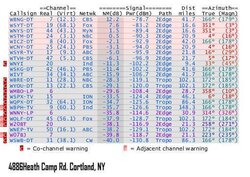Woody Stover said:The hybrid view and other buttons are on the google map in the upper right corner.chrisasst said:Here is my address...I don't see the hybrid view on tvfool?
Whew. Rough sleddin' at your location but with a high gain antenna like the DB8 and a good low-noise preamp it can be done, as jdemaris has said (he's obviously got plenty of experience at snagging weak signals.) Probably best to go with a new antenna; The aluminum of the elements themselves have probably oxidized over the years and won't make good connections. You could try to recondition it, I guess... Heck, I even made a DB2 out of bent aluminum rod, with 1x3" fencing for the reflector screen and it works pretty well with the stronger signals that we have here, although not as well as a factory-made antenna.
Any of the DB antennas are designed to be used outside. Several of your strongest stations are up toward Syracuse in the same general area, so you may be able to get a good basic selection without a rotor. For indoors, you may be able to place the antenna in a window that faces toward the cluster of stations, or maybe the siding won't be an issue. Not sure if you have a second story, but an upstairs window facing the stations would be great. An attic install will lose some signal through roofing materials, but it may work. Indoors is always easier, no lightning worries, not subject to weather, but the signal is better with steel in the air.chrisasst said:Also I do have Aluminum siding so I may be fighting a loosing battle with an inside antenna then right? Can a DB2 be put outside?
You'll just have to try some stuff to see what. Or maybe you have a friend or neighbor in the area who has tried and failed enough times to have figured out what works. :lol: Maybe there's a local internet forum to post on...
...So I will get a DB8 and see what happens. Can I try that without a preamp thing at first? ( don't have the extra $ at this point to buy both ) I do have a second story. As of right now I am looking at 30' ( maybe more) above ground.


